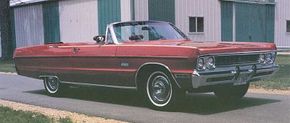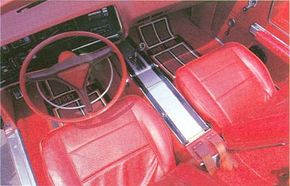Nineteen sixty-nine was a big year for big cars, with brand-new designs from each of the traditional "Low-Price Three." But where Chevy and Ford retained familiar styling cues, the 1969 Plymouth Sport Fury and VIP invited people to "Look What Plymouth's Up To Now" with the most dramatic overhaul of the bunch.
On paper at least, the '69 Furys were exactly the sort of family cruisers the market seemed to want. Shared with that year's new C-body Chryslers and senior Dodges was what Highland Park termed "fuselage styling," the fulsome, rounded look pioneered in spectacular fashion by the slick '68 Dodge Charger. Blown up to full-size scale, it was more lardy than lithe -- and less practical, with raised beltlines noticeably reducing glass area and thus outward vision. But Fury was at least clean and much smoother than before, with just enough knife-edged formality in front and rear fenderlines to appease more conservative types.
Advertisement
Without question the new models looked bulkier, and those looks were not deceiving. Wheelbase increased one inch from 1965-68 to match the 120-inch span of Fury's redesigned competitors (save 122 for wagons, still in the separate Suburban line created for '68). Overall length grew 1.5 inches to a massive 214.5, and width spread nearly two inches to a girthy 79.6. But despite appearances -- and long-held myth -- curb weights were only a few pounds higher model-for-model. The ragtop Sport Fury, for example, weighed just 19 pounds more than its '68 counterpart, the posh VIP hardtop sedan a mere eight pounds more.
There were no big technical changes for '69, so Fury still diverged from its rivals with unit construction (instead of body-on-frame), Chrysler's famed torsion-bar front suspension (versus coil springs), and a familiar lineup of reliable Highland Park engines ranging from the thrifty 225 Slant Six to a burly big-block 440 V-8.
A few styling features did have functional ramifications, however. Wipers, for instance, were now concealed GM-style by a rear hood lip, which seemed a good idea until they became really concealed by snow packed into their recess. Front-door ventwings vanished from air-conditioned hardtop coupes, controversial at the time because they increased wind noise. Also on hand were 15-inch wheels and tires (previously 14s), which didn't quite fill out the newly ballooned bodysides, but did allow for larger, more efficient brakes.
A new and little-known '69 Fury option grouped a two-barrel 383 V-8 with cruise control, power front-disc brakes, long-legged 2.76:1 axle ratio, undercoating, and headlamps-on warning lamp. Plymouth called this the "Turnpike Cruising Package." (One wonders whether they checked that name with Mercury.)
Go to the next page to learn about the 1969 Plymouth Sport Fury and VIPs popularity with consumers.
For more information on cars, see:
- Classic Cars
- Muscle Cars
- Sports Cars
- Consumer Guide New Car Search
- Consumer Guide Used Car Search
Advertisement


